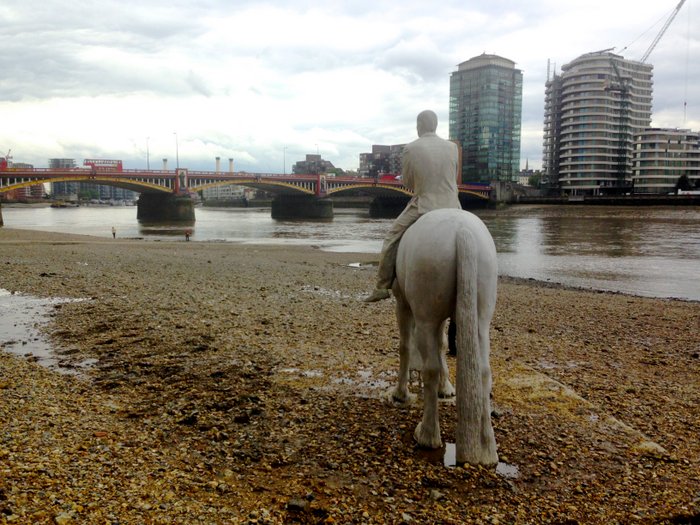What are those ghostly little grayish-white heads on the surface of the Thames River? You’ll have to wait for low tide to find out (or just watch the time-lapse gif below). In honor of the month-long “Totally Thames Festival” held annually in London, underwater sculpture artist Jason deCaires Taylor is not horsing around with these works of art he created for the fest—each statue weighs 12 tons each!
Made out of cement, these giant workhorses with oil drills as heads are posed at different angles on the shore—each with a distinct rider that’s been cast from a real person. Standing in the river by Vauxhall Bridge, not far from the Houses of Parliament, “The Rising Tide” work of art is visible at different degrees depending on the tide.
Luckily, when I was in London last week with a group of journalists checking out the city’s new museum fall openings, the artist was on the shores of the Thames River doing interviews. He graciously obliged answering a few questions:
What inspired “The Rising Tide” project?
Based on the seven meters of water that comes in daily, I related it to climate change and the warning of the sea rising.
And why horses?
The horses are reference to London’s history of using shire horses as workhorses. Also, although they are strong, they are still delicate. And this speaks to how fragile we really are when it comes to global warming.
Which is your favorite of the four?
My favorite is the horse and rider farthest from the bridge (see below). The rider’s name is Trevor—he’s a courier in real life!

Why did you begin doing underwater sculptures?
I studied land and coastal art in school. Then I became a diver and noticed the coral reef declining. It inspired me to do something to help slow the degradation and I started to install artwork under the sea to attract marine life, coral, and algae, so what grows on them changes with the seasons and currents.
Speaking of diving, what are your three favorite dive spots in the world?
The Red Sea; Australia; and Cuba.
What’s next on the watery horizon?
An underwater museum opens in Lanzarote, Canary Islands in October that features 100 of my sculptures.
Where to Travel to See More Underwater Sculptures
In 2006, Taylor founded and created the world’s first underwater sculpture park. Situated off the west coast of Grenada in the West Indies it is now listed as one of the Top 25 Wonders of the World by National Geographic and was instrumental in the creation of a National Marine Protected Area by the local Government.
Following on in 2009 he co-founded MUSA (Museo Subacuático de Arte), a monumental museum with a collection of over 500 of his sculptural works, submerged off the coast of Cancun, Mexico; described by Forbes as one of the world’s most unique travel destinations.
During the summer of 2014, Taylor submerged “Ocean Atlas” in the Bahamas, which is currently the largest single underwater sculpture in the world measuring 5 meters high and weighing over 60 tons.
About Totally Thames 2015
Totally Thames brings the river to life in a celebration of all things arts, cultural, river-related Thames. There are plenty of opportunities to get on and into the water, from paddle steamers to paddle boarding, cruising on a Tall Ship to wild swimming.
This year includes live art in various iterations along the entire 42-mile stretch through the capital. As well as theatre performances, kids’ choirs and a unique contemporary opera, The Lighthouse, accessed by boat at Trinity Buoy Wharf, Totally Thames is delighted to announce the premiere Bascule Chamber Concert inside Tower Bridge. The first ever public event to take place in this fascinating space, composer Iain Chambers will transform this global landmark into a giant musical instrument based on sound recordings taken inside the chambers.
Travel to Totally Thames events by boat. Major boat operators are offering 2-for-1 on river travel throughout September.
 This trip was sponsored by VisitLondon.com and partners but opinions are my own.
This trip was sponsored by VisitLondon.com and partners but opinions are my own.





 Subscribe to our email to get the latest news, travel tips, tricks of the trade, and our most recent posts delivered straight to your inbox monthly.
Subscribe to our email to get the latest news, travel tips, tricks of the trade, and our most recent posts delivered straight to your inbox monthly. 